- Pluto is an object that lies beyond Neptune and also revolves around the Sun. It is smaller than Earth's Moon. When Pluto was first discovered, it was considered a planet in our Solar System.
- However, as more small objects similar to Pluto were found, the International Astronomical Union (IAU) redefined what qualifies as a planet in 2006. According to this new definition, Pluto and other similar objects are now classified as dwarf planets.
Beyond Earth Chapter Notes | Science Olympiad Class 6 PDF Download
| Table of contents |

|
| Introduction |

|
| Stars and Constellations |

|
| Night Sky Watching |

|
| Our Solar System |

|
| Asteroids |

|
| Halley's Comet: A Famous Space Visitor |

|
| The Milky Way Galaxy |

|
| The Universe |

|
| Key Concepts |

|
Introduction
Nubra, a picturesque region in Ladakh, is known for its majestic mountains, glaciers, and clear, cloudless skies. The nights in this region are especially captivating, as the absence of air and light pollution allows thousands of stars to shine brightly. The night sky has long fascinated people, inspiring curiosity about the stars’ size, distance, and patterns. In earlier times, certain stars even guided caravans traveling through Nubra, highlighting the practical as well as the awe-inspiring aspects of the celestial display. Observing the stars and tracing imaginary patterns among them can evoke a sense of wonder and connection with the universe.

Stars and Constellations
- At night, we see many stars in the sky. Some are bright, while others are dim. Stars give off their own light.
- Groups of stars sometimes form patterns that look like familiar shapes. Long ago, our ancestors enjoyed watching these stars. They noticed these patterns and linked them to animals, objects, or characters from stories.

- Different cultures had their own names for these star patterns, often based on their unique stories. These imaginary shapes helped people recognise stars more easily.
Stars and Navigation
- Recognising stars and their patterns was very useful for navigation in ancient times. Before modern technology and tools like the magnetic compass, people, especially sailors and travellers, used stars to find their way at sea or on land.
- Even today, in emergencies, people still use star patterns as a backup way to navigate.
Constellations
These groups of stars that form patterns are called constellations. The stars in a constellation are often connected by imaginary lines to make the pattern easier to see. For example, one famous constellation is Orion, which looks like a hunter.
- Orion’s belt is made of three stars in a row.
- Some people imagine that Orion, the hunter, is followed by his dog (another constellation called Canis Major) and that they are fighting a bull (a constellation called Taurus).
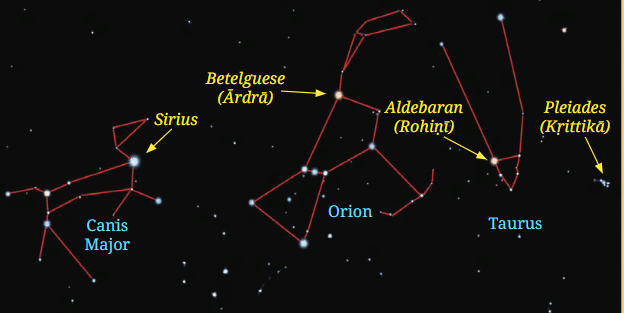
International Astronomical Union (IAU)
- Different cultures had their own ways of naming and defining these constellations, so to keep everything organized, an international group called the International Astronomical Union (IAU) decided on official boundaries for 88 constellations.
- This way, the entire sky is divided into 88 regions, each named after a constellation.
More about Constellations
In the night sky, there are two famous star patterns called the Big Dipper and the Little Dipper. 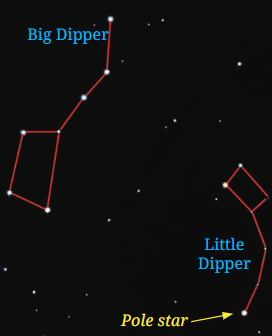
- These patterns are part of larger constellations, with the Big Dipper being part of Ursa Major and the Little Dipper part of Ursa Minor.
- A special star called the Pole Star, or Polaris, is part of the Little Dipper.
- This star is unique because it stays in the same spot in the sky, always pointing North. This makes it useful for finding the North direction, especially in the Northern Hemisphere.
Do you know?
In India, the Big Dipper is known as Saptaṛiṣhi, and the Pole Star is called Dhruva tārā. These patterns and stars have different stories and meanings in various cultures. For example, some tribes in Central India see the four main stars of the Big Dipper as a “grandmother’s cot,” with the other three stars representing thieves trying to steal it. Fishermen along the Konkan coast imagine these stars as a boat, with the last three stars forming the neck of the boat.
Night Sky Watching
How to See Stars and Constellations at Night?
- When the night is clear and without clouds, you can see many stars in the sky. However, if you live in a big city, the sky is often not clear, and you might only see a few stars. This is because of something called light pollution, as well as smoke and dust in the air.

- Light pollution happens when there is too much artificial light at night. In places like villages, where there is less light pollution, you can see many more stars. Sometimes, tall buildings and trees around your house can also block your view of the night sky. The best places to see the night sky are open and dark areas with little light.
- Not all stars and constellations can be seen from every place on Earth or at all times of the year. For instance, the Pole Star cannot be seen from the southern part of Earth. To identify a star or a constellation, you need to know what it looks like and where to find it in the sky.
- You can use pictures of constellations to help you recognise their patterns. There are also sky mapping apps that you can download on your phone, which can tell you when and where to see a star or constellation from your location.
Understanding Light Pollution
- Light pollution is increasing rapidly around the world, making it harder for us to enjoy and study the objects in the night sky.
- To combat this, some dark sky reserves and parks have been created. In these places, light pollution is controlled to keep the skies dark for research and stargazing.
- There are also organizations that work to teach people about ways to reduce light pollution.
Apps for Identifying Stars, Constellations, and Planets
- Sky Map is a useful app that helps you identify stars, constellations, and planets using your mobile phone.
- Stellarium is another app that offers similar features. The computer version of Stellarium is available for free download and comes with many useful features.
Our Solar System
The Solar System is like a big family in space. At the centre of this family is the Sun, which is like a huge ball of fire that gives us light and warmth. 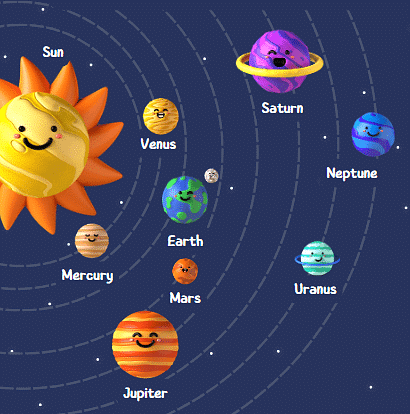
The Sun
- The Sun is a star, and it's the closest star to our planet Earth. It's a gigantic, extremely hot ball of gases. The Sun shines so brightly because it gives out a huge amount of energy.

- The Sun is the main source of heat and light for our planet, providing the energy necessary for life. Although the Sun is about 100 times wider than Earth, it appears smaller in the sky because it is very far away from us.
- Despite its size, the Sun looks bigger than other stars because it is much closer to us. Other stars are farther away, which is why they look like tiny points of light in the sky, even though some of them are much larger than the Sun. During the day, the Sun's brightness makes it difficult to see these other stars.
- Besides the Sun and Earth, there are many other objects in the sky that, along with Earth, form the Solar System. Most of these objects move around the Sun in a path called revolution.
Some facts about Sun
- The distance from the Earth to the Sun is about 150 million kilometres. To help understand this vast distance, scientists use a special unit called the 'astronomical unit' (au), which is roughly the same as the distance between the Earth and the Sun.
- The Sun is not just a giant ball of hot gas; it is also the brightest object in our sky and the main source of light and heat for our planet. Because of this, ancient people in many cultures, including India, worshipped the Sun as a god. In India, the Sun is called Sürya.
- The Sun's heat is very important for keeping the Earth at a comfortable temperature, which is necessary for life. Sunlight is also crucial for plants to grow. Plants are the foundation of the food chain, providing food and oxygen for animals and humans.
- Additionally, the Sun plays a key role in creating climate, seasons, weather, the water cycle, and winds. All of these factors are vital for sustaining life on Earth.
Planets
- A planet is a large, round object that orbits around the Sun. Our Earth is one of these planets. It takes about a year for Earth to go all the way around the Sun. There are other planets that do the same thing.
- There are eight planets in our Solar System, listed in order of their distance from the Sun: Mercury, Venus, Earth, Mars, Jupiter, Saturn, Uranus, and Neptune.

- The four planets closest to the Sun- Mercury, Venus, Earth, and Mars—are smaller and have solid surfaces covered with rocks.
1. Venus is often seen shining brightly in the morning and evening, which is why people sometimes call it the Morning Star or the Evening Star, even though it is not a star.
2. Mars is known as the Red Planet because its soil is reddish in color. - A large part of Earth's surface is covered with water, which makes it look blue from space. Because of this, Earth is also called the Blue Planet.
- The four planets farthest from the Sun—Jupiter, Saturn, Uranus, and Neptune—are much larger than Earth and are mostly made of gas. These giant gas planets have big, flat rings around them made of dust and rock.
- Planets get most of their energy from the Sun. Generally, the farther a planet is from the Sun, the colder it is. However, a planet's atmosphere can trap heat and make it warmer. For example, Venus is hotter than Mercury even though it is farther from the Sun.
- Among the planets, Venus is the easiest to see because it is very bright. After the Sun and the Moon, Venus is the third brightest object in the sky. Mercury, Mars, Jupiter, and Saturn can also be seen without a telescope, but they look like small, shining dots, similar to stars.
Pluto
Natural Satellites
Natural satellites are objects that orbit around planets. They are smaller in size than the planets they orbit. Moons are examples of natural satellites. Earth has one Moon, while Mars has two moons. The outer planets, like Jupiter, Saturn, Uranus, and Neptune, have many moons. 
The Moon
- The Moon, which is Earth's natural satellite, takes about 27 days to orbit around our planet. It is the closest celestial neighbour to Earth. Unlike Earth, the Moon has very little atmosphere. In terms of size, the Moon is about one-quarter the diameter of Earth.
- The Moon's surface is marked by many round, bowl-shaped depressions known as craters. These craters are mainly caused by the impact of asteroids or rocks from space striking the Moon's surface. Because the Moon lacks an atmosphere, water, and life, these craters remain visible for a very long time.
- Even though the Moon is far away, humans have sent spacecraft to explore and learn more about it. India has launched three Chandrayaan missions to study the Moon, and there are plans for more missions in the future.
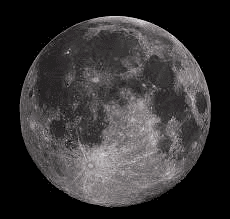
Understanding Satellites
- A satellite is something that moves around a larger object in space. For example, the Earth is a satellite of the Sun because it orbits around the Sun.
- The Moon is a satellite of the Earth. It is about 3,84,000 kilometers away from our planet.
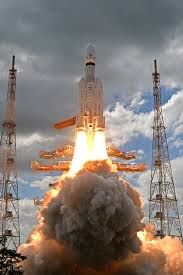
India has made significant strides in exploring the Moon through its Chandrayaan missions. The first mission, Chandrayaan-1, was launched in 2008, followed by Chandrayaan-2 in 2019.
- The third mission, Chandrayaan-3, was launched in July 2023, and its Vikram lander, carrying the Pragyan rover, successfully landed on the Moon's surface on August 23, 2023. This achievement made India the first country in the world to land near the Moon’s south pole, a region that has been little explored.
- To honor this success, the Government of India has declared August 23 as 'National Space Day.' Looking ahead, a fourth mission, Chandrayaan-4, is being planned, with the goal of bringing back soil and rock samples from the Moon.
Asteroids
- Asteroids are small, rocky objects in the Solar System that have an irregular shape, unlike the nearly spherical Sun and planets.
- Many asteroids orbit the Sun in a region between the orbits of Mars and Jupiter, known as the asteroid belt. Occasionally, some asteroids come very close to Earth as they travel along their paths around the Sun.
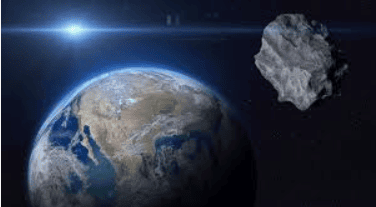
Comets
- Comets are like visitors from the far reaches of our Solar System. They are made of dust, gas, rocks, and ice. When a comet gets close to the Sun, the heat causes the frozen materials to evaporate, creating a bright tail. This is why comets can look so spectacular!
- When comets are far away from the Sun, they appear dim and are hard to see without a telescope.
- Some comets have regular orbits that bring them close to the Sun periodically, while others may escape the Solar System entirely.
- Some comets can break apart, crash into the Sun, or collide with planets as they travel through space.

What Makes Up the Solar System?
- The Solar System is made up of the Sun, eight planets, their moons, and many smaller objects like asteroids and comets.
- The Sun is the largest and heaviest object in the Solar System. It produces almost all the energy for the Solar System. Other objects in the Solar System, like the planets and their moons, shine because they reflect the sunlight that comes from the Sun.
Halley's Comet: A Famous Space Visitor
- Halley's Comet is a well-known comet that visits our sky every 76 years.
- The last time Halley's Comet was seen was in 1986.
The Milky Way Galaxy
- On a moonless night, when viewed from a dark location far from city lights, an extended faint band of light can be seen stretching across the sky from north to south.
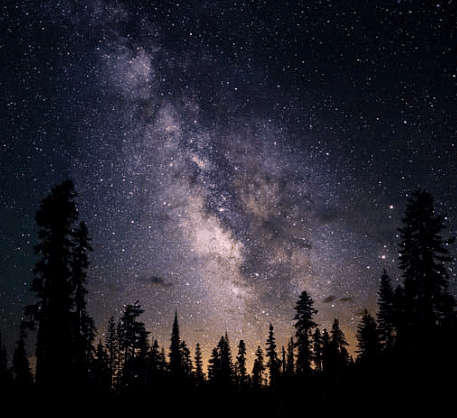
- This band of light is our home galaxy, known as the Milky Way Galaxy, or Ākāśha Gangā. A galaxy like the Milky Way contains millions to billions of stars, and our Solar System is just one small part of this vast galaxy.
The Universe
- Beyond the Milky Way Galaxy, there are countless other galaxies in outer space. Scientists study these galaxies to learn more about stars, galaxies, and the universe as a whole.
- One of the big questions scientists are trying to answer is whether there is life anywhere else in the universe.
- So far, the search for life has focused mainly on exoplanets, which are planets that orbit stars other than our Sun, within our galaxy.
- Although scientists have not yet found any evidence of life on these exoplanets, the search continues.

Key Concepts
- Asteroid: A small rocky object orbiting the Sun, mostly found between Mars and Jupiter.
- Moon: A natural satellite that orbits a planet.
- Solar System: The Sun and all the objects that orbit it, including planets, moons, asteroids, and comets.
- Constellation: A group of stars forming a recognizable pattern.
- Comet: An icy body that releases gas and dust, forming a glowing coma and tail when near the Sun.
- Milky Way Galaxy: The galaxy that contains our Solar System.
- Planet: A large object that orbits a star and does not produce its own light.
- Stars: Massive, luminous spheres of plasma that emit light and heat.
- Revolution: The movement of an object around another object, such as a planet around the Sun.
- Satellite: An object that orbits a planet.
- Sun: The star at the centre of our Solar System, providing light and heat to the planets.
|
70 videos|150 docs|104 tests
|
FAQs on Beyond Earth Chapter Notes - Science Olympiad Class 6
| 1. What are the main types of stars found in the night sky? |  |
| 2. How can I start observing constellations? |  |
| 3. What are asteroids and where can they be found in our solar system? |  |
| 4. What is the Milky Way Galaxy and its significance in the universe? |  |
| 5. How do scientists study the universe beyond our solar system? |  |
















